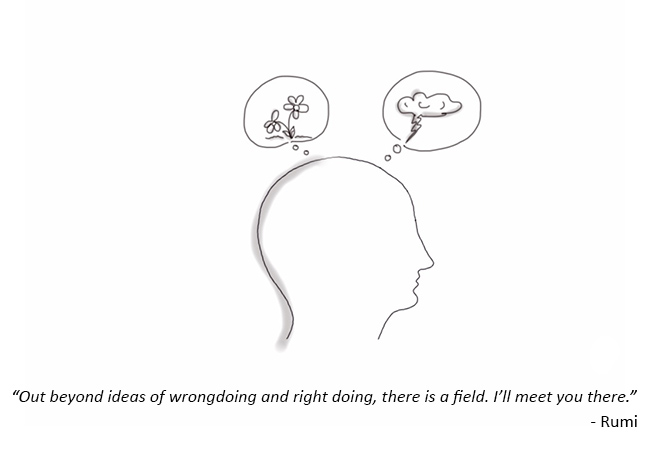Each of us brings unique perspectives, experiences, and beliefs to every conversation. Because of this we regularly encounter ideas that conflict with or challenge ours. Given the brain’s need for certainty (it likes to know what’s what) and to be in relationship with others (we feel safer), we can experience a significant amount of discomfort or cognitive dissonance in meetings. Unfortunately, in order to reduce this tension, we tend to develop arguments or stories to justify our ideas and build a case against those of others. We get caught in “either/or” thinking.
You can probably feel the constriction in your body when you move into an “I-need-to-be-right” stance. This posture elicits a combative response in others and is counter-productive to finding solutions somewhere between your story about right and wrong and those of others.
This form of cognitive hijacking can be prevented or managed by applying “integrative thinking.” This includes examining relationships among issues and the root causes of issues; considering the various ideas or models of “reality” as hypotheses and investigating them carefully; looking at how potential pieces of solutions might fit together into a whole new one; resisting the inclination to simplify things so we can feel certain and “get on with it;” and avoiding “either/or” thinking and embracing “both/and” thinking.
When Alan G. Lafley became CEO of Proctor and Gamble in 2000, their stock price had fallen nearly 50 percent in the previous six months and the company was locked in a debate about how they would regain their eminence in consumer goods marketing. Some leaders believed that the only way forward was to continue the heavy investment in research and development. Others thought that the right answer was to let the investment in R & D decrease to historical levels and focus on what had made them successful in the past: marketing and brand-building. Lafley did not get caught in the company’s either/or thinking. He and his team crafted a strategy that they dubbed “Connect and Develop.” They leveraged their manufacturing, marketing, and distribution capabilities by partnering with small companies, individual inventors and academics who were generating a disproportionately greater amount of innovation than big corporations. (For more about the P & G and other organizations’ use of integrative thinking see “The Opposable Mind” by Roger Martin.)
To prevent the destructive tendencies evoked by cognitive dissonance, include the following in the design and conduct of your meetings:
- Schedule a reasonable amount of time to achieve the desired outcomes; test this with key stakeholders to see if they deem the time allotments “reasonable.”
- Maintain a humane conversational pace so people feel calm and more able to notice and manage the discomfort of dissonance when it occurs.
- Encourage people to consider their models of reality as hypotheses not as “the way things are.”
The key is to be willing to experience and manage the discomfort of conflicting ideas, wade into the unknown as we explore possibilities, and not ignore or make light of the tension people feel while doing so. Normalize the tension by naming it and encouraging people to stay present with it. “We have a number of ideas that, on the surface at least, seem contradictory. Let’s take a moment of quiet and individually consider what all these ideas might have in common or whether there is another perhaps larger idea that connects them in some way.” Or, “This might seem a bit messy and uncomfortable at the moment. I suggest we just let this be messy for a while longer and see what emerges from it. Let’s do our best to hang in there with one another and this uncertainty. Are you all willing to do that?” Usually when anyone names it, people recognize their emotions and it helps them to not be driven by them.
If we can acknowledge (without criticism) the discomfort we feel trying to honestly consider different versions of “the truth,” we can then mindfully calm ourselves down enough to make room for possibilities beyond ideas of right and wrong. It is in this space that seemingly disparate ideas can emerge into new consonant ones.
Cognitive dissonance is a form of cognitive hijacking that occurs when we perceive, think and make decisions with unconscious biases and impaired functioning of the brain. Emotional hijacking is usually the precursor to cognitive hijacking. It is the result of real or perceived threats to our sense of safety or survival. I explored two other forms of cognitive hijacking—confirmation bias and loss aversion—in the previous two posts.
Thank you to Heather Equinoss for the image.

